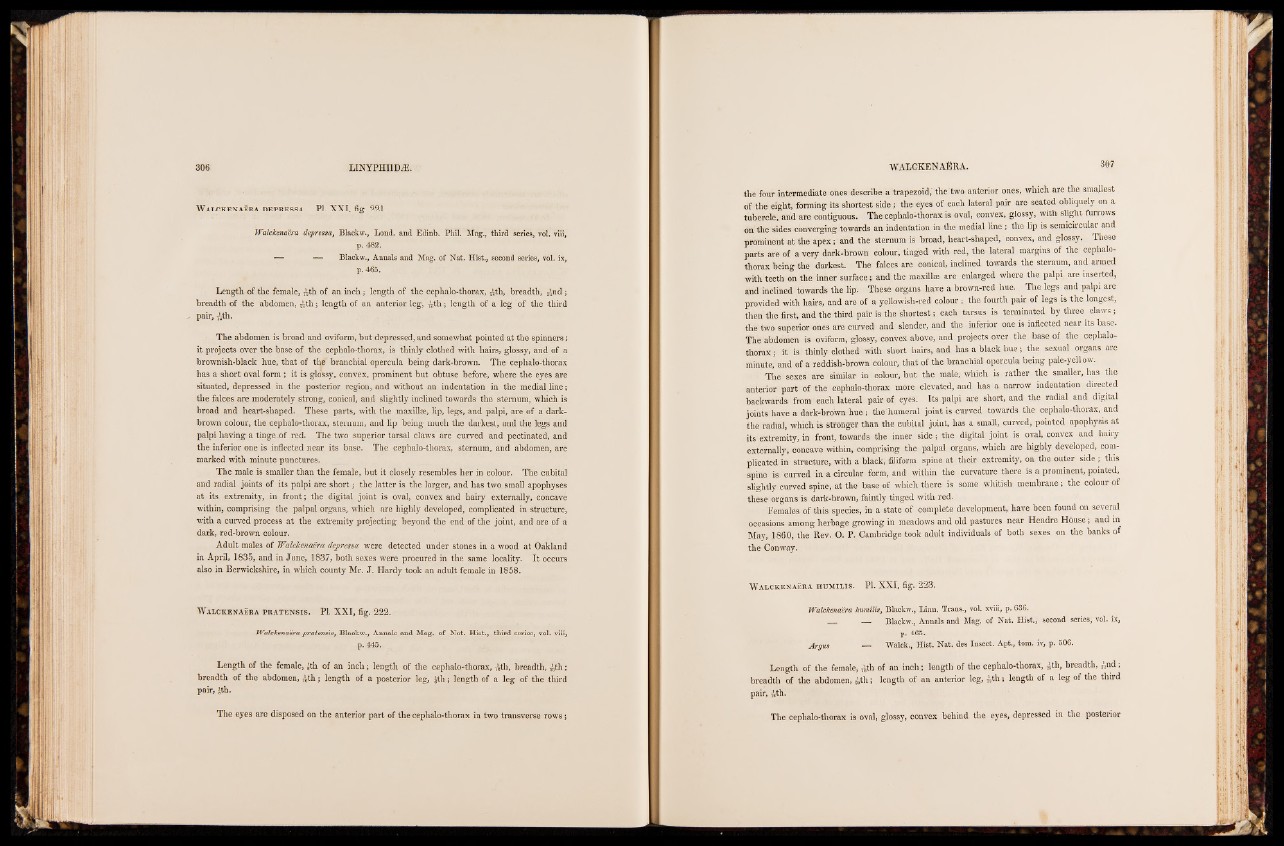
Walckenaera depressa. PI. XXI, fig. 221.
Walckenaera depressa, Blackw., Loud, and Edinb. Phil. Mag., third series, vol. viii,
p. 482.
— Blackw., Annals and Mag. of Nat. Hist., second series, vol. ix,
p. 465.
Length of the female, jUh of an inch; length of the cephalo-thorax, ^th, breadth, ^nd ;
breadth of the abdomen, ~ th ; length of an anterior leg, i5th ; length of a leg of the third
pair, ^th.
The abdomen is broad and oviform, but depressed, and somewhat pointed at the spinners;
it projects over the base of the cephalo-thorax, is thinly clothed with hairs, glossy, and of a
brownish-black hue, that of the branchial opercula being dark-brown. The cephalo-thorax
has a short oval form ; it is glossy, convex, prominent but obtuse before, where the eyes are
situated, depressed in the posterior region, and without an indentation in the medial line;
the falces are moderately strong, conical, and slightly inclined towards the sternum, which is
broad and heart-shaped. These parts, with the maxillae, lip, legs, and palpi, are of a dark-
brown colour, the cephalo-thorax, sternum, and lip being much the darkest, and the legs and
palpi having a tinge .of red. The two superior tarsal claws are curved and pectinated, and
the inferior one is inflected near its base. The cephalo-thorax, sternum, and abdomen, are
marked with minute punctures.
The male is smaller than the female, but it closely resembles her in colour. The cubital
and radial joints of its palpi are short; the latter is the larger, and has two small apophyses
at its extremity, in front; the digital joint is oval, convex and hairy externally, concave
within, comprising the palpal organs, which are highly developed, complicated in structure,
with a curved process at the extremity projecting beyond the end of the joint, and are of a
dark, red-brown colour.
Adult males of Walckenaera depressa were detected under stones in a wood at Oakland
in April, 1835, and in June, 1837, both sexes were procured in the same locality. It occurs
also in Berwickshire, in which county Mr. J. Hardy took an adult female in 1858.
Walckenaera pratensis. PI. XXI, fig. 222.
Walckena'era pratensis, Blackw., Annals and Mag. of Nat. Hist., third series, vol. viii,
p. 445.
Length of the female, gth of an inch; length of the cephalo-thorax, ^th, breadth, ^th;
breadth of the abdomen, ^ th; length of a posterior leg, gth; length of a leg of the third
pair, |th.
The eyes are disposed on the anterior part of the cephalo-thorax in two transverse rows;
the four intermediate ones describe a trapezoid, the two anterior ones, which are the smallest
of the eight, forming its shortest side ; the eyes of each lateral pair are seated obliquely on a
tubercle, and are contiguous. The cephalo-thorax is oval, convex, glossy, with slight furrows
on the sides converging towards an indentation in the medial line ; the lip is semicircular and
prominent at the apex; and the sternum is broad, heart-shaped, convex, and glossy. These
parts are of a very dark-brown colour, tinged with red, the lateral margins of the cephalo-
thorax being the darkest. The falces are conical, inclined towards the sternum, and armed
with teeth on the inner surface ; and the maxillæ are enlarged where the palpi are inserted,
and inclined towards the lip. These organs have a brown-red hue. The legs and palpi are
provided with hairs, and are of a yellowish-red colour ; the fourth pair of legs is the longest,
then the first, and the third pair is the shortest ; each tarsus is terminated by three claws ;
the two superior ones are curved and slender, and the inferior one is inflected near its base.
The abdomen is oviform, glossy, convex above, and projects over the base of the cephalothorax;
it is thinly clothed with short hairs, and has a black hue ; the sexual organs are
minute, and of a reddish-brown colour, that of the branchial opercula being pale-yellow.
The sexes are similar in colour, but the male, which is rather the smaller, has the
anterior part of the cephalo-thorax more elevated, and has a narrow indentation directed
backwards from each lateral pair of eyes. Its palpi are short, and the radial and digital
joints have a dark-brown hue ; the humeral joint is curved towards the cephalo-thorax, and
the radial, which is stronger than the cubital joint, has a small, curved, pointed apophysis at
its extremity, in front, towards the inner side ; the digital joint is oval, convex and hairy
externally, concave within, comprising the palpal organs, which are highly developed, complicated
in structure, with a black, filiform spine at their extremity, on the outer side; this
spine is curved in a circular form, and within the curvature there is a prominent, pointed,
slightly curved spine, at the base of which there is some whitish membrane ; the colour of
these organs is dark-brown, faintly tinged with red.
Females of this species, in a state of complete development, have been found on several
occasions among herbage growing in meadows and old pastures near Hendre Hôusè ; and in
May, ,1860, the Rev. O. P. Cambridge took adult individuals of both sexes on the banks of
the Conway.
Walckenaera humilis. PI. XXI, fig. 223.
Walckenaera humilis, Blackw., Linn. Trans., vol. xviii, p. 636.
__ — Blackw., Annals and Mag. of Nat. Hist., second series, vol. ix,
p. 465.
Argus — Walck., Hist. Nat. des Insect. Apt., tom. iv, p. 506.
Length of the female, Ath of an inch; length of the cephalo-thorax, ^th, breadth, ^nd;
breadth of the abdomen, ^ th; length of an anterior leg, i,th ; length of a leg of the third
pair, nth.
The cephalo-thorax is oval, glossy, convex behind the eyes, depressed in the posterior